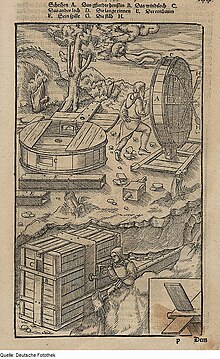Weather wheel
A weather wheel , also known as a wind turbine , weather fan or weather drum, is a weather machine that was used in mining for ventilation . Weather wheels are driven either manually or by machine.
construction
The weather wheel consists of a round housing in which a shaft is rotatably mounted in the middle. The case is six feet in diameter and 1.5 feet wide. But weather wheels with rectangular housings were also built. There are two openings in the housing, one on each side. A weather duct can be attached to one of the openings . The other opening remains open and is used to suck in fresh air. Eight fan-shaped blades are mounted on the shaft inside the housing. In the case of the round housings, the wings are mounted in such a way that they connect exactly to the head and side surfaces without hitting them. This is not possible with the angular housings, which means that some of the air remains in the housing. Therefore, weatherwheels with a square housing are not as effective as weatherwheels with a round housing. On the outside of the shaft there is a crank with which the shaft can be set in rotation. The housing can either be placed directly on the floor or attached to a trestle. If the housing is attached to a bracket, four wind blades can be attached to the shaft end instead of the crank. As a result, the weather wheel is driven by wind power like a windmill. The disadvantage here, however, is that if the wind is insufficient, the mine workings are not ventilated.
Function and use
If the shaft is set in rotation, the air in the housing is moved in one direction by the blades. This compresses the air and the momentum of the wings pushes it towards the opening. The air flowing in through the other opening now moves these air masses out of the housing. This air is now pressed through the duct to the site. This leads to a necessary change in weather . A weather wheel that works in this way is called a weather blower. If the weather wheel is to work as a weather vacuum, i.e. to suck the weather out of the mine, the openings on the weather wheel must be exchanged. This means that a duct is connected to the suction side, i.e. the opening through which the fresh air is sucked in. Now the weather wheel sucks the weather out of the mine and blows it into the open.
Individual evidence
- ↑ a b c d e f Johann Heinrich Moritz Poppe: Encyclopedia of the entire mechanical engineering, or complete instruction in practical mechanics and machine theory. Fifth part, published by Georg Boß, Leipzig 1810
- ^ Heinrich Veith: German mountain dictionary with evidence. Published by Wilhelm Gottlieb Korn, Breslau 1871
- ↑ a b c d e f g H. F. Rumpf: General Real Encyclopedia of the Entire Art of War. Second volume, second edition, printed and published by AW Hayn, Berlin 1827
- ^ A b c Georg Agricola: Twelve books on mining and metallurgy. In commission VDI-Verlag GmbH, Berlin
- ↑ Explanatory dictionary of the technical terms and foreign words that occur in mining in metallurgy and in salt works and technical articulations that occur in salt works. Falkenberg'schen Buchhandlung publishing house, Burgsteinfurt 1869
- ^ Wilhelm Leo: Textbook of mining science. Printed and published by G Basse, Quedlinburg 1861

